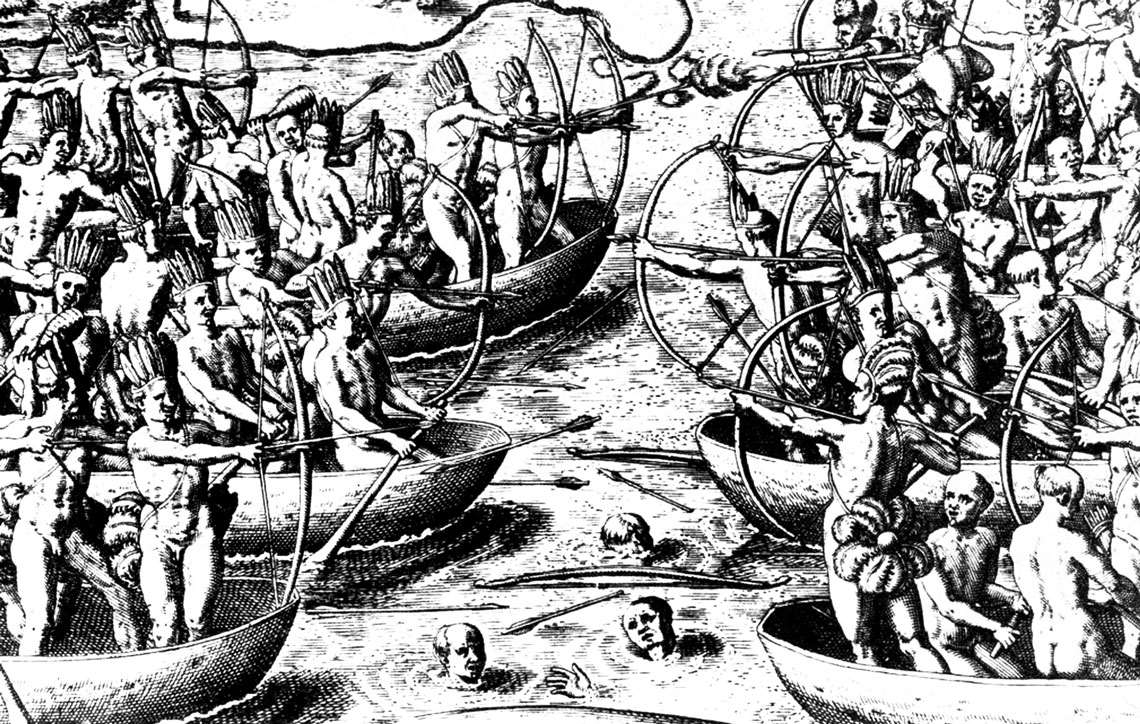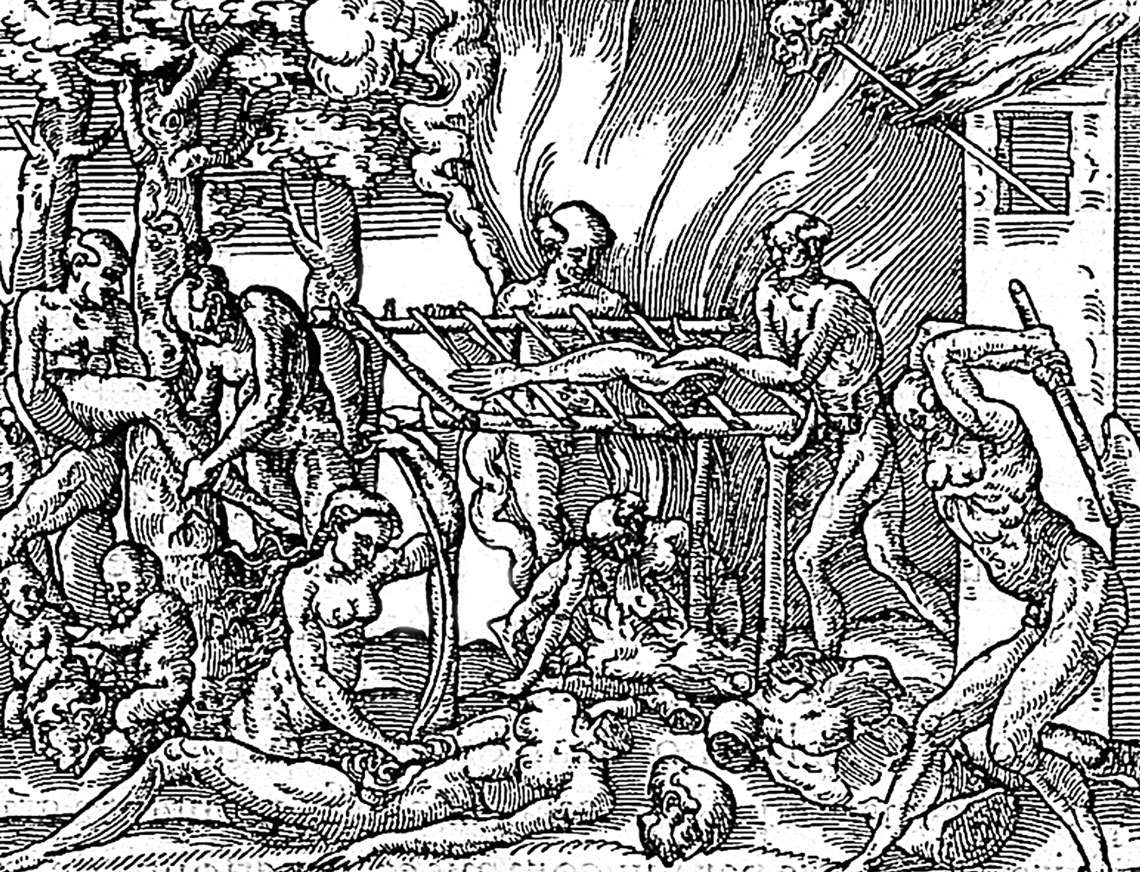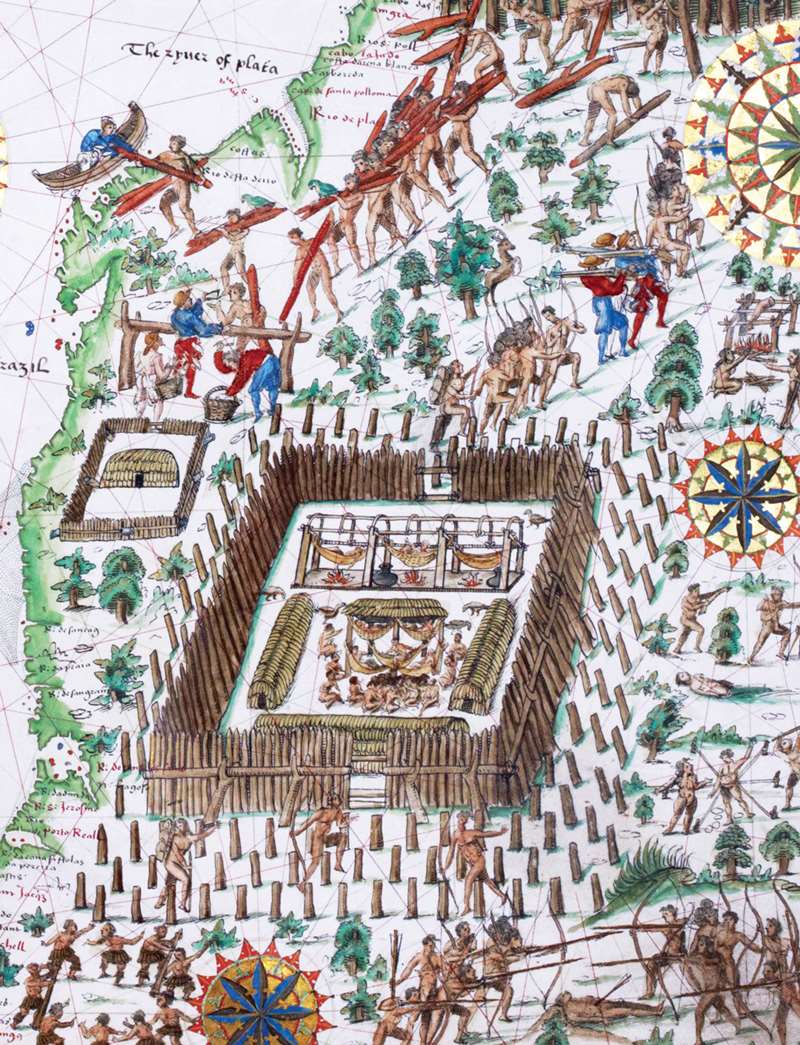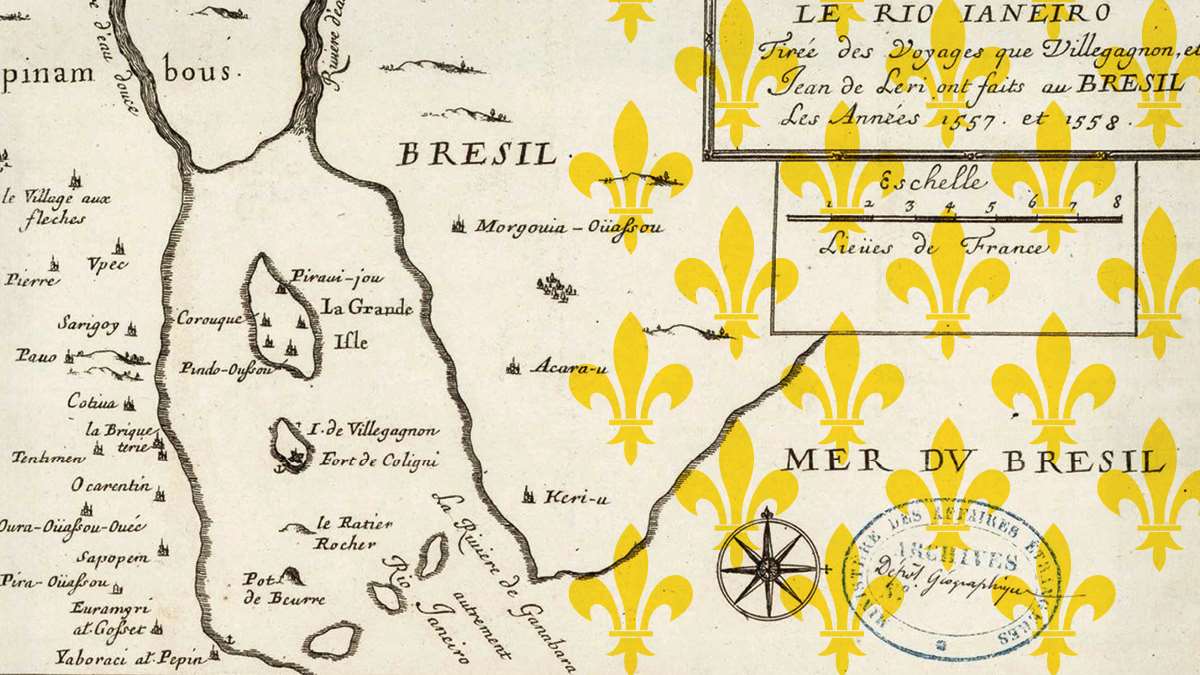Durand de Villegaignon (1510–1571), left a lasting legacy: it foreshadowed the religious wars that would ravage Europe in the following decade; it kindled the Western imagination of indigenous peoples; it challenged European intellectuals to question their own world; and it produced a vast body of iconographic and narrative material.
A recently published book, França Antártica: Ensaios interdisciplinares (Antarctic France: Interdisciplinary essays; UNICAMP, 2020)—with contributions from historians, musicologists, linguists, and other subject-matter experts—explores this manifold legacy as a way to frame this brief episode in Brazilian history within a broader context than just the Portuguese reconquest. What did it represent for the native peoples? How does it relate to what was happening in Europe and to colonial expansion? How does it affect current views on Brazil’s early history? “Other than the founding of Rio, Portuguese America would not have been much different if there had never been a French presence in Guanabara,” says Maria Berbara, an art historian at the Theory and History of Art Department of Rio de Janeiro State University (UERJ), and one of the organizers of the book. “However, Antarctic France left a huge repertoire of texts, images, ideas, and concepts that helped shape the Western image of Brazil and the Americas.”
The stories about the New World that reached European audiences in the sixteenth century, published by the Belgian engraver and publisher Theodor de Bry (1528–1598), were hugely popular, in large part because they were presented in a way that resonated with Europeans’ worldviews at the time. For example, the illustrations of the Brazilian landscape in some documents—like the map on the cover of the book—were directly based on representations of the Garden of Eden in printed editions of the Bible. “Numerous pamphlets were circulated at the time and were immensely successful with the public. One of the reasons is that these texts touched on what were then very sensitive issues, such as religion,” says Berbara. “Villegagnon himself wrote a pamphlet. Letters from the colony were also widely circulated, such as those written by the Jesuits. Hans Staden’s [1525–1576] account, which took place further south, was widely read.”
Antarctic France foreshadowed the events to come on the European continent
The most significant sixteenth-century works describing Antarctic France are those of French Franciscan friar and cosmographer André Thévet (1502–1590), and Calvinist traveler and pastor Jean de Léry (1536–1613). In 1557, Thévet published The newfound world, or Antarctike, in which he recounted his brief experience as the chaplain of the Villegaignon fleet. Being a cosmographer, the friar documented the exotic landscapes he and his compatriots discovered. His book La Cosmographie universelle (The universal cosmography), dated 1575, also contains important passages about Brazil. In 1578, in large part to refute what he referred to as “untruths” told by the Catholic Thévet, the Protestant Léry published the book History of a voyage to the land of Brazil. Léry’s account is rich in descriptions of the natives’ way of life, including the Tupi language, their music—the subject of one of the essays in the new book—their customs, and their body paint.
Sheila Hue, a professor at UERJ’s Institute of Language and Literature and a co-organizer of the book alongside Berbara and Renato Menezes, says the authors were able to reconstruct the myriad facets of Antarctic France because the Europeans’ accounts provide more than just a projection of their own ideas. “In describing the territories, they used a documentary and empirical approach co-mingled with classical and medieval references. A letter by Pero Vaz de Caminha [1450–1500], for example, contains a detailed description of indigenous body painting. André Thévet transcribes Christian prayers in the Tupi language and provides a sort of conversation guide containing priceless information about the ways of life of those peoples,” she says.

Wikimedia Commons
Shown left is Americae tertia pars, a 1592 illustration by Théodore de Bry, featured in Hans Staden’s bookWikimedia CommonsThe expedition
Felling and loading out dyewood logs was virtually the only significant economic activity in present-day Brazil in 1555, when a group of 600 Frenchmen landed on an island then called Serigipe, off the southern bank of Guanabara Bay, later renamed in honor of Villegagnon. There they built Fort Coligny, named after admiral Gaspard de Coligny (1519–1572), who funded the expedition. Another 300 Frenchmen would arrive at the colony in 1557, including a group of Calvinists, among them Léry.
Guanabara Bay, although affording an excellent natural harbor and terrain ideally suited for the construction of military defenses, had little relevance to the Portuguese possessions in South America, then primarily consisting of three cities: Salvador, Olinda, and São Vicente. Despite this the Portuguese, under King Sebastian (1554–1578) and Governor-General Mem de Sá (1500–1572), launched a campaign in 1560 to take back the territory.
As in other parts of the continent, the war in Guanabara was a two-layered conflict. At the same time that European nations were vying for control of the territory they had discovered a few decades earlier, indigenous peoples were fighting each other in the land of their ancestors.
These overlapping interests led to, often long-lasting intercontinental alliances. Guanabara Bay was home to two branches of the Tupinambá: the Tamoio and the Temiminó. The former had taken over part of the latter’s territory a few years prior. In the following decade, under the leadership of Arariboia (?–1589), the Temiminó returned and defeated their rivals, while the Portuguese defeated the French between 1560 and 1567. Arariboia is considered the founder of the present-day city of Niterói.

THEVET, A. Les singularitez de la France Antarctique, Autrement Nommée Amerique, & De Plusieurs Terres & Isles Decouuertes de Nostre Temps
On the right is a 1557 engraving credited to Bernard de Poisduluc, found in the book The new found world, or Antarctike, by André ThevetTHEVET, A. Les singularitez de la France Antarctique, Autrement Nommée Amerique, & De Plusieurs Terres & Isles Decouuertes de Nostre TempsThe French expedition was a violation of the Treaty of Tordesillas of 1494, pursuant to which those lands belonged to the Portuguese Crown. The shores of Guanabara Bay had for decades attracted merchants and pirates, drawn by the lucrative trade in dyewood. In 1550, in the royal entry for Henry II of France at Rouen, a theatrical performance depicted trade between the French and the Tupinambá, with some performers having been brought on ships from Guanabara Bay.
However, the breaking of the treaty was more than just about trade. “Why was France’s violation of the Treaty of Tordesillas such a serious matter? Because it represented more than a dispute between nations. The treaty had been signed under the aegis of the Catholic Church and ratified by Pope Julius II in 1506,” notes Berbara. “The treaty was broken amid the Protestant Reformation crisis and just before a terrible period of wars that would embroil Europe in bloodshed in the following decades, showing how political and economic disputes, such as the dyewood trade, can intermesh with religious ones.”
“This book shows how Antarctic France foreshadowed what was to come on the European continent,” writes Ronaldo Vainfas, a retired professor of history at Fluminense Federal University (UFF), in his introduction to the book. Disputes over the dogma of transubstantiation—according to which the bread and wine in the Eucharist became the actual body and blood of Christ—sparked a violent conflict between Catholics and Protestants living on the island. To formalize their creed, four Calvinists living in Fort Coligny wrote a document in 1558 called the “Guanabara Confession of Faith,” the first Protestant writing in Brazil. Just before subsequently abandoning the colony he had founded, Villegagnon expelled several Huguenots (the French branch of Calvinism) from the fort. To escape Portuguese pursuit and attacks, groups of Calvinists began to live on the mainland with the natives.
Villegagnon’s relationship with religion is ambiguous. He was raised Catholic, and once enrolled as a knight of the Order of Malta. However, he was a friend of the Protestant John Calvin (1509–1564) and collaborated with the Huguenots on several occasions. “Villegagnon is a controversial figure and accounts of him, even during his lifetime, were conflicting. Some refer to him as a Catholic, others as a Protestant; some say he converted from a Catholic to a Protestant, and others vice versa,” says Hue.

National Library
The founding of Rio de Janeiro, depicted in a colored engraving by Antônio Firmino MonteiroNational LibraryThe Guanabara colony was a small-scale prototype presaging, as it were, the division that would engulf France and involve many of the colonists themselves in the following decades. The French Wars of Religion lasted from 1562 to 1598, their most infamous episode being the St. Bartholomew’s Day massacre in 1572, when at least 5,000 Huguenots, including Admiral Coligny, were killed by Catholic mobs in and around Paris. “Antarctic France is a microcosm that encapsulates the conceptual and ideological issues that would dominate the following decades in Europe. It is like a chest from which we can draw hints and clues,” says Berbara.
Just as the French side was torn apart by conflicts surrounding the Reformation, the Portuguese campaign to retake Guanabara was also waged as a religious war.
It can be described as the spearpoint of the Counter-Reformation, although the Portuguese narratives of the time described it as a continuation of the wars for conquest of territory, which began in the twelfth century against the Arabs and continued in North Africa until Portugal’s defeat in the battle of Alcácer-Quibir, in 1578. Although many of Villegagnon’s men were Catholic, in the eyes of the Portuguese troops they were heretics and infidels. “In a way, the narrative from the reconquest of the Iberian Peninsula was recycled in the conquest of Rio, namely that it was necessary to expel the enemies of Christianity. Before they were the Moors; now they were the French. In other captaincies, the enemies—seen as any obstacle to colonization—were the indigenous people,” notes Hue. “We find in the Portuguese texts the same tone as in the chronicles about their battles against the Moors: a righteous war against the Devil, now personified in the French. The reconquest of Guanabara was an ambition of the Crown as well as of the Church, as can be seen in the close alliance that existed between Governor-General Mem de Sá and the Jesuits, such as Manoel da Nóbrega [1517–1570] and José de Anchieta [1534–1597].”
“Letters by Nóbrega and Anchieta clearly articulate the Portuguese narrative,” continues Hue. Religion was a core element, and always intertwined with politics: the city of São Sebastião do Rio de Janeiro was so named in honor of Saint Sebastian but also the like-named King of Portugal. “This was a way to place the very foundation of the city under the aegis of the monarch. From its founding, it would be under the direct protection of the Portuguese Crown,” says Hue. A miracle attributed to Saint Sebastian was also part of the narrative during the campaign against the French. In the “Battle of the Canoes,” in which the Tamoio and the French attacked the Portuguese and their Temiminó allies, Saint Sebastian was said to have appeared to the Portuguese, signaling that victory would be theirs. “The narratives in this episode seem to imitate a similar narrative in connection with the foundation of the Portuguese Kingdom—the legend of Ourique, which held that Jesus Christ himself had appeared to King Afonso Henriques [1109?–1185] in 1139,” says Hue.

The British Library
Detail of a map of Brazil’s coast composed of 12 miniature maps, found in the Boke of idrography, an atlas produced by Jean Rotz in 1542The British LibraryCannibalism
A broader perspective on Antarctic France can also shed new light on a recurring theme in the writings of this period: cannibalism, a practice that horrified the first Europeans to arrive in present-day Brazil. The 1580 essay “Of cannibals,” by the philosopher Michel de Montaigne (1533–1592), describes how the Tupinambá ceremoniously ate the bodies of their dead enemies. But the essay serves a broader purpose: it is one of the first texts to question the European tendency to see only savagery in the ways of other peoples. Montaigne suggested that treating foreigners as barbarians was a way in which Europeans reinforced their own conviction of being civilized, while shrouding the dark side of their own culture.
The accounts and iconography that arrived from the newly discovered continent therefore helped to shape the image Europeans had of themselves. Berbara notes how one of Villegagnon’s detractors, the Calvinist theologian Pierre Richer (1506?–1580), compared the admiral to Polyphemus, the cannibal cyclops who is tricked by Odysseus in Homer’s Odyssey. She believes Richer chose the Homeric character as a way to associate a reference to European antiquity with the cannibalism seen in the Americas. “It would be too simplistic to see representations of cannibalism as merely denoting the exotic and the unknown. In Europe, to be sure, the idea of cannibalism served to characterize otherness in a negative light. But the meaning of cannibalism had originally derived from Europe itself, so exposure to New World cannibalism spoke to something that was already within the European,” argues Berbara.
A few years after the destruction of Fort Coligny, the ensuing wars between Catholics and Huguenots would tear France’s social fabric, to a point where there were even reports of cannibalism, such as during the siege of Sancerre in 1572. Léry witnessed this episode and noted that, having seen the cannibalism of the Tupinambá, he considered that of the Europeans to be the more terrible: whereas in Brazil human flesh was consumed as part of a ritual, in Europe it was a gesture of human degradation.
However, the cannibal is just one element of a broader picture in which, according to Berbara, the Tupinambá served as a “rhetorical figure” that helped Europeans to reflect on their own image. “There was a duplicity in the characterization of Indians during this period. On the one hand, they were described as being innocent, simple, and without guile. On the other, they were described as brave, ruthless warriors,” she notes. “We can see the notion of a noble savage, corrupted by civilization, beginning to emerge in these writings. But what civilization is being alluded to if not the European civilization itself? The rhetorical figure of the Tupinambá thus helped to alter the notion of otherness: the “others” were no longer just the Muslims, the Vikings, and other peoples that haunted medieval Europe. Within Christendom itself, there were other ‘others’ who could be even more ruthless.”
Republish